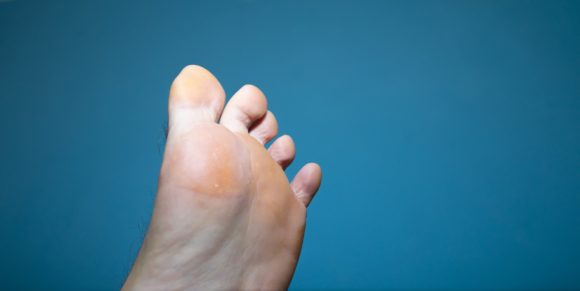Q: What is the best treatment for athlete’s foot?
If you suffer from “athlete’s foot”, you have lots of company: nearly 1 out of every 5 Americans have a fungus infecting their skin or nails, called tinea or ringworm. The tinea fungus thrives in places that are warm, moist and dark, so people tend to get infections from tinea in places that are tightly covered and sweaty. The medical name for tinea infections depends on which area of your body is affected. For example, a foot infection with tinea is tinea pedis (“athlete’s foot”) while tinea in your groin area is called tinea cruis (“jock itch”).
The tinea fungus infects your feet through blisters or cracks in the skin between your toes. Taking good care of your feet and keeping the skin of your feet intact can go a long way to help keep you from getting infected in the first place. Wearing sandals when using public showers is a good idea, along with being especially careful when drying between your toes, as being too rough can cause a crack in the skin and give fungus a chance to get started.
Fungus loves moisture, so keeping your feet as dry as possible also discourages infection. If you can, wearing sandals with open toes keeps your feet open to the air and less sweaty, and the sunlight on your feet retards the growth of tinea.
Other key strategies to help keep your feet as dry as possible include avoiding tight shoes and changing your socks frequently. Some people wear running socks designed to wick moisture away and reduce friction that can create blisters. Putting powder on your feet before you put on your socks can also help absorb moisture.
Which remedy should you use for your athlete’s foot? There are several effective options that don’t require a prescription. My personal recommendation is terbinafine 1% gel, originally available by prescription only but available over-the-counter (OTC) as Lamisil AT® gel. Terbinafine also comes as a cream but I recommend gel instead because it is less moisturizing than the cream and less moisture is a good thing when treating a fungal infection like tinea.
When you select an anti-fungal product from the pharmacy shelf, it can get really confusing. Tolnaftate is available both as a generic and as the brand name Tinactin®, but the company that sells Lamisil® AT gel sells several other anti-fungal agents under the Lamisil® name.For example, Lamisil AF® cream contains clotrimazole, Lamisil AF® powder aerosol contains miconazole, and Lamisil Ultra® cream contains butenafine.
The most important thing in treating athlete’s foot is not which product you choose, but HOW LONG you use it. Normally, when your skin goes back to normal, it’s cured, but with tinea fungus, that’s not good enough. The tinea fungus stays in your skin, and the only way to get rid of it completely is for you to shed that skin, which takes several weeks.
Here are 5 Tips on Treating Athlete’s Foot:
- Keep your feet as dry as possible.
Fungus loves warm, moist and dark places. Always dry carefully between your toes after bathing or swimming, avoiding tight shoes and changing your socks frequently, twice daily if possible. Wearing sandals instead of shoes whenever possible also helps keeps your feet dry.
- Use cotton or sport socks.
Washing your socks in very hot water helps to kill off tinea which can live in your socks and re-infect your feet.
- Avoid using powder alone for active infections.
Don’t use antifungal powder to treat an active infection because it’s not powerful enough by itself to eradicate the fungus. Apply your antifungal treatment twice a day for a minimum of two weeks, or until your symptoms are completely gone. If your symptoms don’t completely resolve in 2 weeks, keep treating your feet twice a day.
- Don’t quit too soon.
Once your symptoms disappear, continue treating twice a day for another two weeks. This is very important because it helps make sure the fungus gets completely shed out of your skin. If you leave any tinea fungus inside the skin layers of your feet, they can start multiplying again and soon you’ll be right back where you started.
- Use antifungal powder to discourage reinfection.
Once your athlete’s foot symptoms have gone and you’ve finished treating it for 2 additional weeks, you can switch to a maintenance program to discourage it from coming back. Using a powder or spray powder 1-2 times a day helps control moisture as well as prevent future infections.


